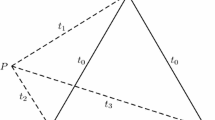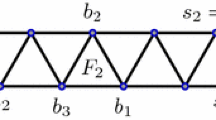Abstract
A 0/1-simplex is the convex hull of n+1 affinely independent vertices of the unit n-cube In. It is nonobtuse if none of its dihedral angles is obtuse, and acute if additionally none of them is right. Acute 0/1-simplices in In can be represented by 0/1-matrices P of size n × n whose Gramians G = P⊤P have an inverse that is strictly diagonally dominant, with negative off-diagonal entries.
In this paper, we will prove that the positive part D of the transposed inverse P−⊤ of P is doubly stochastic and has the same support as P. In fact, P has a fully indecomposable doubly stochastic pattern. The negative part C of P−⊤ is strictly row-substochastic and its support is complementary to that of D, showing that P−⊤ = D−C has no zero entries and has positive row sums. As a consequence, for each facet F of an acute 0/1-facet S there exists at most one other acute 0/1-simplex Ŝ in In having F as a facet. We call Ŝ the acute neighbor of S at F.
If P represents a 0/1-simplex that is merely nonobtuse, the inverse of G = P⊤P is only weakly diagonally dominant and has nonpositive off-diagonal entries. These matrices play an important role in finite element approximation of elliptic and parabolic problems, since they guarantee discrete maximum and comparison principles. Consequently, P−⊤ can have entries equal to zero. We show that its positive part D is still doubly stochastic, but its support may be strictly contained in the support of P. This allows P to have no doubly stochastic pattern and to be partly decomposable. In theory, this might cause a nonobtuse 0/1-simplex S to have several nonobtuse neighbors Ŝ at each of its facets.
In this paper, we study nonobtuse 0/1-simplices S having a partly decomposable matrix representation P. We prove that if S has such a matrix representation, it also has a block diagonal matrix representation with at least two diagonal blocks. Moreover, all matrix representations of S will then be partly decomposable. This proves that the combinatorial property of having a fully indecomposable matrix representation with doubly stochastic pattern is a geometrical property of a subclass of nonobtuse 0/1-simplices, invariant under all n-cube symmetries. We will show that a nonobtuse simplex with partly decomposable matrix representation can be split in mutually orthogonal simplicial facets whose dimensions add up to n, and in which each facet has a fully indecomposable matrix representation. Using this insight, we are able to extend the one neighbor theorem for acute simplices to a larger class of nonobtuse simplices.
Similar content being viewed by others
References
R. B. Bapat, T. E. S. Raghavan: Nonnegative Matrices and Applications. Encyclopedia of Mathematics and Applications 64, Cambridge University Press, Cambridge, 1997.
A. Berman, R. J. Plemmons: Nonnegative Matrices in the Mathematical Sciences. Classics in Applied Mathematics 9, SIAM, Philadelphia, 1994.
D. Braess: Finite Elements. Theory, Fast Solvers, and Applications in Solid Mechanics. Cambridge University Press, Cambridge, 2001.
J. Brandts, A. Cihangir: Counting triangles that share their vertices with the unit n-cube. Proc. Conf. Applications of Mathematics 2013 (J. Brandts et al., eds. ). Institute of Mathematics AS CR, Praha, 2013, pp. 1–12.
J. Brandts, A. Cihangir: Geometric aspects of the symmetric inverse M-matrix problem. Linear Algebra Appl. 506 (2016), 33–81.
J. Brandts, A. Cihangir: Enumeration and investigation of acute 0/1-simplices modulo the action of the hyperoctahedral group. Spec. Matrices 5 (2017), 158–201.
J. Brandts, S. Dijkhuis, V. de Haan, M. Křížek: There are only two nonobtuse triangulations of the unit n-cube. Comput. Geom. 46 (2013), 286–297.
J. Brandts, S. Korotov, M. Křížek: Dissection of the path-simplex in Rn into n pathsubsimplices. Linear Algebra Appl. 421 (2007), 382–393.
J. Brandts, S. Korotov, M. Křížek: The discrete maximum principle for linear simplicial finite element approximations of a reaction-diffusion problem. Linear Algebra Appl. 429 (2008), 2344–2357.
J. Brandts, S. Korotov, M. Křížek, J. Šolc: On nonobtuse simplicial partitions. SIAM Rev. 51 (2009), 317–335.
S. C. Brenner, L. R. Scott: The Mathematical Theory of Finite Element Methods. Texts in Applied Mathematics 15, Spinger, New York, 1994.
R. A. Brualdi: Combinatorial Matrix Classes. Encyclopedia of Mathematics and Its Applications 108, Cambridge University Press, Cambridge, 2006.
R. A. Brualdi, H. J. Ryser: Combinatorial Matrix Theory. Encyclopedia of Mathematics and Its Applications 39, Cambridge University Press, Cambridge, 1991.
M. Fiedler: Über qualitative Winkeleigenschaften der Simplexe. Czech. Math. J. 7 (1957), 463–478. (In German. )
N. A. Grigor’ev: Regular simplices inscribed in a cube and Hadamard matrices. Proc. Steklov Inst. Math. 152 (1982), 97–98.
J. Hadamard: Résolution d’une question relative aux déterminants. Darboux Bull. (2) 17 (1893), 240–246. (In French. )
C. R. Johnson: Inverse M-matrices. Linear Algebra Appl. 47 (1982), 195–216.
C. R. Johnson, R. L. Smith: Inverse M-matrices II. Linear Algebra Appl. 435 (2011), 953–983.
G. Kalai, G. M. Ziegler, (Eds. ): Polytopes—Combinatorics and Computation. DMV Seminar 29, Birkhäuser, Basel, 2000.
Author information
Authors and Affiliations
Corresponding author
Rights and permissions
About this article
Cite this article
Brandts, J., Cihangir, A. On the combinatorial structure of 0/1-matrices representing nonobtuse simplices. Appl Math 64, 1–31 (2019). https://doi.org/10.21136/AM.2018.0207-18
Received:
Accepted:
Published:
Issue Date:
DOI: https://doi.org/10.21136/AM.2018.0207-18
Keywords
- acute simplex
- nonobtuse simplex
- orthogonal simplex
- 0/1-matrix
- doubly stochastic matrix
- fully indecomposable matrix
- partly decomposable matrix




